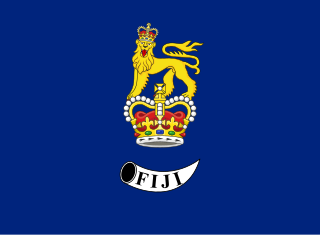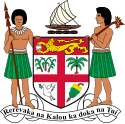
Governor-general, or governor general, is the title of an office-holder. In the context of governors-general and former British colonies, governors-general are appointed as viceroy to represent the monarch of a personal union in any sovereign state over which the monarch does not normally reign in person. Governors-general have also previously been appointed in respect of major colonial states or other territories held by either a monarchy or republic, such as Japan in Korea and France in Indochina.

The national flag of Fiji was adopted on 10 October 1970. The state arms have been slightly modified but the flag has remained the same as during Fiji's colonial period. It is a defaced cyan "Blue Ensign", with the shield from the national coat of arms. It has remained unchanged since Fiji was declared a republic in 1987, despite calls from some politicians for changes.

The governor-general of Fiji was the representative of the Fijian monarch in the Dominion of Fiji from the country's independence in 1970 until the monarchy's deposition in 1987.

The Fijian coups d'état of 1987 resulted in the overthrow of the elected government of Fijian Prime Minister Timoci Bavadra, the deposition of Elizabeth II as Queen of Fiji, and in the declaration of a republic. The first coup d'état, in which Bavadra was deposed, took place on 14 May 1987; a second coup d'état on 25 September ended the monarchy, and was shortly followed by the proclamation of a republic on 10 October. Both military actions were led by Lieutenant Colonel Sitiveni Rabuka, then third in command of the Royal Fiji Military Forces.
These are lists of territorial governors by century and by year, such as the administrators of colonies, protectorates, or other dependencies. Where applicable, native rulers are also listed.

Arthur Charles Hamilton-Gordon, 1st Baron Stanmore was a British Liberal Party politician and colonial administrator. He had extensive contact with Prime Minister William Ewart Gladstone.

Edwin Warfield was an American politician and a member of the United States Democratic Party, and the 45th Governor of Maryland in the United States from 1904 to 1908. From 1902 to 1903 served president general of the National Society of the Sons of the American Revolution.

The chief justice is Fiji's highest judicial officer. The office and its responsibilities are set out in Chapter 5 of the 2013 Constitution of Fiji. The chief justice is appointed by the president on the advice of the prime minister.

The Legislative Council of Fiji was the colonial precursor to the present-day Parliament, which came into existence when Fiji became independent on 10 October 1970.

The Colony of Fiji was a Crown colony that existed from 1874 to 1970 in the territory of the present-day nation of Fiji. London declined its first opportunity to annex the Kingdom of Fiji in 1852. Ratu Seru Epenisa Cakobau had offered to cede the islands, subject to being allowed to retain his Tui Viti title. His demand was unacceptable to both the British and to many of his fellow chiefs, who regarded him only as first among equals, if that. Mounting debts and threats from the United States Navy had led Cakobau to establish a constitutional monarchy with a government dominated by European settlers in 1871, following an agreement with the Australian Polynesia Company to pay his debts. The collapse of the new regime drove him to make another offer of cession in 1872, which the British accepted. On 10 October 1874, Britain began its rule of Fiji, which lasted until 10 October 1970.

The British Western Pacific Territories (BWPT) was a colonial entity created in 1877 for the administration of a series of Pacific islands in Oceania under a single representative of the British Crown, styled the High Commissioner for the Western Pacific. Except for Fiji and the Solomon Islands, most of these colonial possessions were relatively minor.

The coat of arms of Fiji is the heraldic device consisting of a shield divided quarterly by Cross of St. George and charged with a gold lion at the top, supported by two Fijian warriors, one on each side, and topped with a canoe as the crest. Adopted in 1908 by a Royal Warrant, it has been the coat of arms of Fiji since that year, having been retained after independence in 1970. The escutcheon from the arms is featured on the flag of Fiji.

Fiji was an independent state from 1970 to 1987, a Commonwealth realm in which the British monarch, Elizabeth II, remained head of state as Queen of Fiji, represented by the Governor-General. The state was the successor of the British Colony of Fiji which was given independence in October 1970 and it survived until the Republic of Fiji was proclaimed on 6 October 1987 after two military coups, at which time Queen Elizabeth II was removed as head of state. During this time, Fiji's highest court was the Judicial Committee of the Privy Council, which was above the Supreme Court of Fiji in the Fijian judicial system.

The monarchy of Fiji arose in the 19th century, when native ruler Seru Epenisa Cakobau consolidated control of the Fijian Islands in 1871 and declared himself king, or paramount chief, of Fiji. Three years later, he voluntarily ceded sovereignty of the islands to Britain, making Fiji a crown colony within the British Empire.

The Tudor Crown, also known as the Imperial Crown, is a widely used symbol in heraldry of the United Kingdom. In use officially from 1902 to 1953 and again from 2022, it represents both the British monarch personally and "the Crown", meaning the sovereign source of governmental authority. As such, it appears on numerous official emblems in the United Kingdom, British Empire and Commonwealth.
The Chief Justice of the High Commissioner's Court, more commonly known as the Chief Judicial Commissioner for the Western Pacific, was the chief judicial officer throughout the British Western Pacific Territories from 1877 through 1976. This was a supra-colonial entity established by the Western Pacific Orders-in-Council 1877, and by the Pacific Order-in-Council 1893. Headed by a High Commissioner for the Western Pacific, who was also ex officio the Governor of Fiji, until the end of 1952, it included numerous islands, mostly small, throughout Oceania. Composition varied over time, but Fiji (1877–1952) and the Solomon Islands (1893–1976) were its most durable members.

The majority of Fiji's islands were formed through volcanic activity starting around 150 million years ago. Today, some geothermic activity still occurs on the is lands of Vanua Levu and Taveuni. Fiji was settled first by the Lapita culture, around 1,500–1,000 years BC, followed by a large influx of people with predominantly Melanesian genetics about the time of the beginning of the Common Era. Europeans visited Fiji from the 17th century, and, after a brief period as an independent kingdom, the British established the Colony of Fiji in 1874. Fiji was a Crown colony until 1970, when it gained independence as the Dominion of Fiji. A republic was declared in 1987, following a series of coups d'état.





































